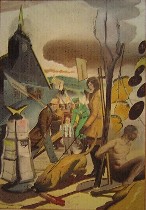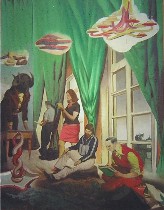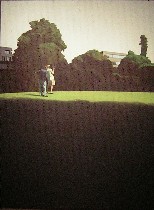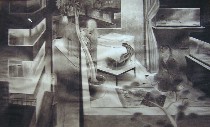 “Life After Death,” a collection of recent paintings from Leipzig, Germany, are on display at MASS MoCA, including several by Neo Rauch. The exhibit, which is subtitled “New Leipzig Paintings from the Rubell Family Collection,” helped to expand for me the context in which Rauch is painting. The other painters are a decade behind Rauch, having studied at the Leipzig Art Academy while Rauch worked there as a teaching assistant (left, Rauch’s “Demonstrations”).
“Life After Death,” a collection of recent paintings from Leipzig, Germany, are on display at MASS MoCA, including several by Neo Rauch. The exhibit, which is subtitled “New Leipzig Paintings from the Rubell Family Collection,” helped to expand for me the context in which Rauch is painting. The other painters are a decade behind Rauch, having studied at the Leipzig Art Academy while Rauch worked there as a teaching assistant (left, Rauch’s “Demonstrations”). The six younger artists began their studies there after the 1989 fall of the Berlin Wall, a surprising decision given the way that political power had shifted. All of them as well as Rauch remain in Leipzig.
 The shift in political power after the fall of the Berlin Wall is the subtext of many of these paintings, which project a shaky, threatening world. The work for the most part reflects the socialist realism approach of the Leipzig Art Academy, but then takes those passe techniques out of the realm of propaganda and into the realm of disquieting, shaky milieus (image right, David Schnell’s “Planks”).
The shift in political power after the fall of the Berlin Wall is the subtext of many of these paintings, which project a shaky, threatening world. The work for the most part reflects the socialist realism approach of the Leipzig Art Academy, but then takes those passe techniques out of the realm of propaganda and into the realm of disquieting, shaky milieus (image right, David Schnell’s “Planks”).
The scenes are at once matter-of-fact and weird.
 In Rauch’s “Dictation” (left) a woman takes notes from a beast in 19th century dress as workers, one perhaps a terrorist, mind their own business in a space that bears the trappings of government pomp and circumstance at the same time that a chandelier and other indecipherable things (meat? false objects of desire) hang in pools of blank white flatness.
In Rauch’s “Dictation” (left) a woman takes notes from a beast in 19th century dress as workers, one perhaps a terrorist, mind their own business in a space that bears the trappings of government pomp and circumstance at the same time that a chandelier and other indecipherable things (meat? false objects of desire) hang in pools of blank white flatness.
 The look of a didactic school book illustration hangs over Rauch’s depictions and over the images of Christoph Ruckhaberle. The stylized, rubbery stretch-figures in motion in “Theater” (right) raise the issue of what’s more theatrical, real life or the play inside. The action is mysterious and non-sensical, with a sense of quick response to some danger while others in the scene pay no attention. The people are all maneuvering in shadow, while harsh daylight spotlights a deserted street.
The look of a didactic school book illustration hangs over Rauch’s depictions and over the images of Christoph Ruckhaberle. The stylized, rubbery stretch-figures in motion in “Theater” (right) raise the issue of what’s more theatrical, real life or the play inside. The action is mysterious and non-sensical, with a sense of quick response to some danger while others in the scene pay no attention. The people are all maneuvering in shadow, while harsh daylight spotlights a deserted street.
 Matthias Weischer’s rattan chair in a brown, unpeopled room is one of several of his paintings featuring dreary walls with the painting’s surface scraped away in spots, and claustrophic space with the main light source from beyond a covert hallway. One of Weischer’s paintings suggested a corner wall behind a wall in what was otherwise just a dreary brown hallway. Again, the light came from an undetermined source. The light and shadows make me think of Edward Hopper without the people. And that reference seems to me to be all over this show. Light and shadow are a key subject in this work.
Matthias Weischer’s rattan chair in a brown, unpeopled room is one of several of his paintings featuring dreary walls with the painting’s surface scraped away in spots, and claustrophic space with the main light source from beyond a covert hallway. One of Weischer’s paintings suggested a corner wall behind a wall in what was otherwise just a dreary brown hallway. Again, the light came from an undetermined source. The light and shadows make me think of Edward Hopper without the people. And that reference seems to me to be all over this show. Light and shadow are a key subject in this work.
 That filmic, noir quality is also in Tim Eitel’s scenarios of anonymous figures in deserted places with strong lights and shadows. The barren spaces threaten, and yet there are touches of humor–a dumpster as an important element in “Container,” an empty shadowed foreground occupying more than half the painting in “Film.” The person holding the camera in “Film” has it pointed at nothing that appears worth filming, only gothic trees which screen the brute modern architecture of office buildings.
That filmic, noir quality is also in Tim Eitel’s scenarios of anonymous figures in deserted places with strong lights and shadows. The barren spaces threaten, and yet there are touches of humor–a dumpster as an important element in “Container,” an empty shadowed foreground occupying more than half the painting in “Film.” The person holding the camera in “Film” has it pointed at nothing that appears worth filming, only gothic trees which screen the brute modern architecture of office buildings.
 The vertiginous, cluastophobia in Schnell’s “Planks,” the suffocating high-contrast of Martin Kobe’s untitled interior (left), the compression of space of an apartment balcony where outside is as compressed as any interior could ever be in Tilo Baumgartel’s “The Pause” (below, right) all speak to a sense of a precarious, compressed existence. I thought the Japanese people–the woman on the floor painting a poster in German as the man looks over the balcony– and the inky squid in the tank (I took this for the artist) were a good parallel–life in tight spaces lived under glass.
The vertiginous, cluastophobia in Schnell’s “Planks,” the suffocating high-contrast of Martin Kobe’s untitled interior (left), the compression of space of an apartment balcony where outside is as compressed as any interior could ever be in Tilo Baumgartel’s “The Pause” (below, right) all speak to a sense of a precarious, compressed existence. I thought the Japanese people–the woman on the floor painting a poster in German as the man looks over the balcony– and the inky squid in the tank (I took this for the artist) were a good parallel–life in tight spaces lived under glass.
 If paintings and drawings can be taken as truth, life in Leipzig is still behind the wall and there is no escape. That this group has made a decision to remain there is startling.
If paintings and drawings can be taken as truth, life in Leipzig is still behind the wall and there is no escape. That this group has made a decision to remain there is startling.









